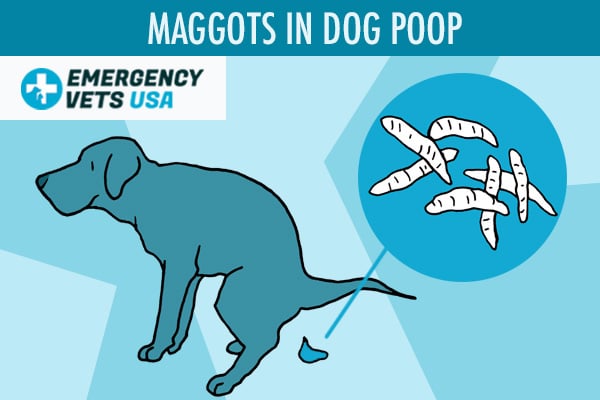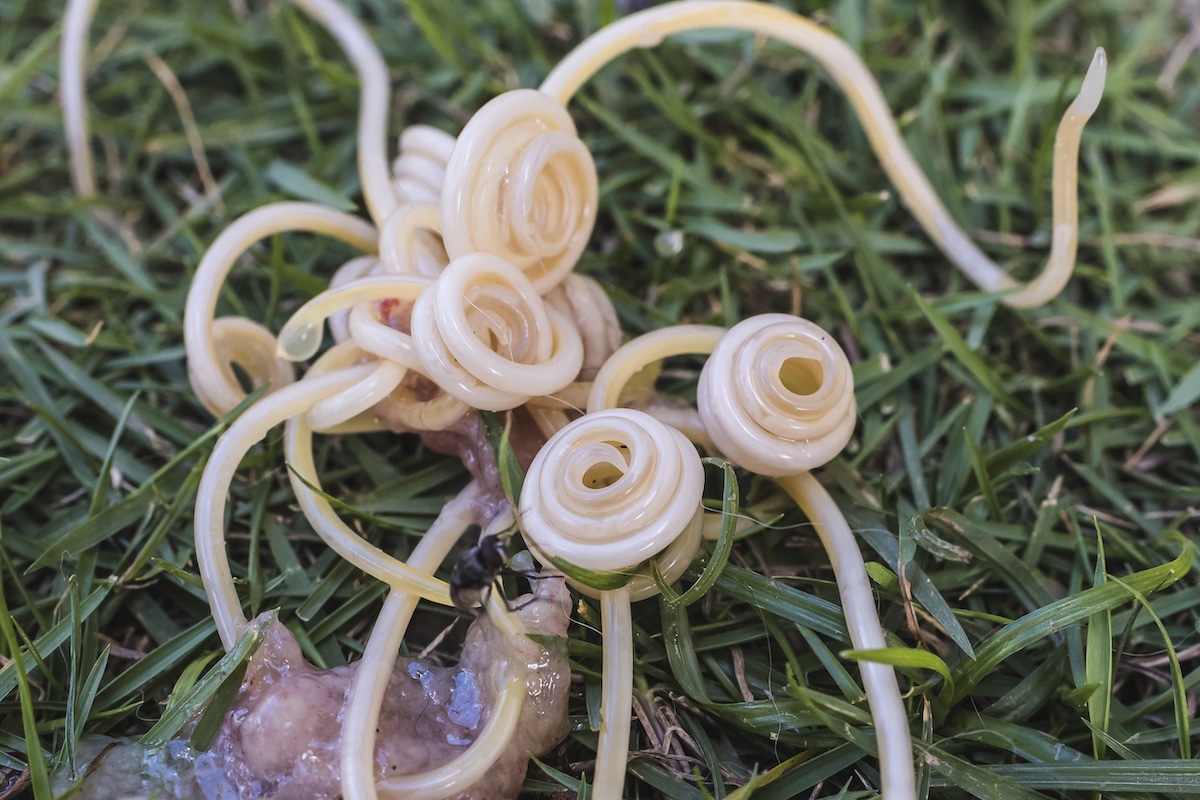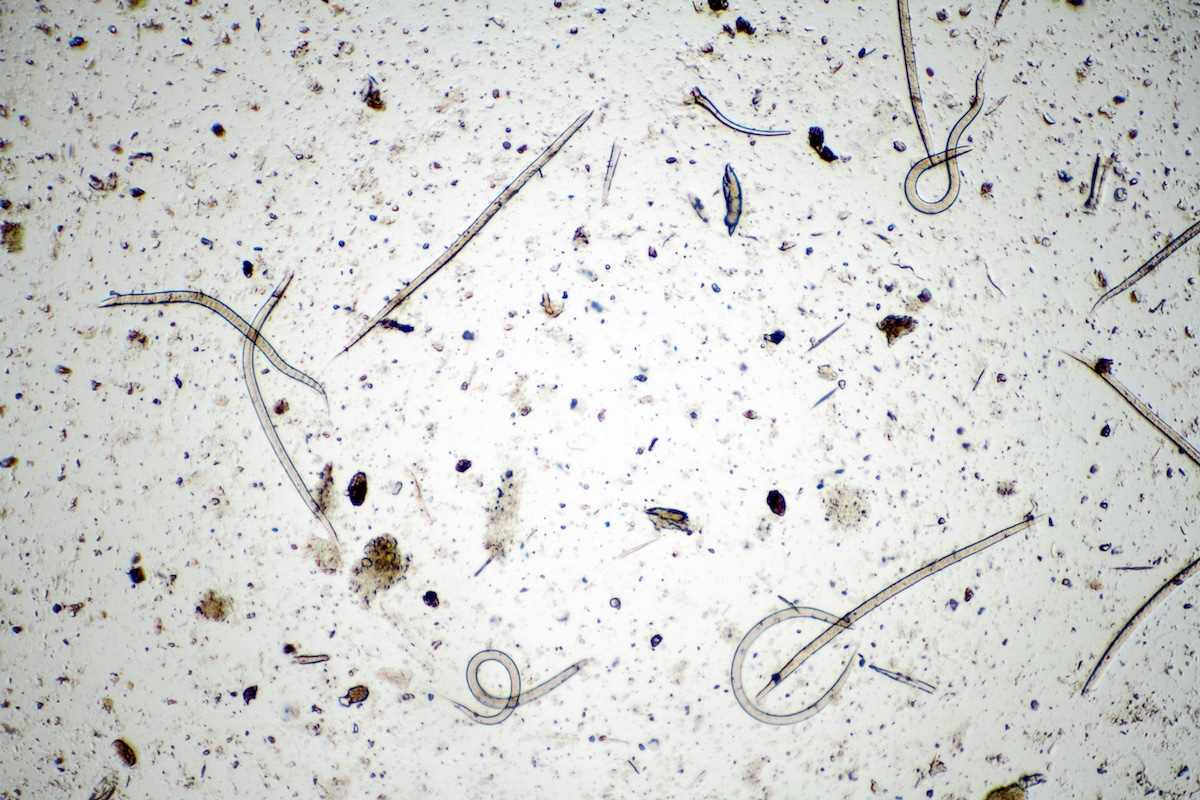Maggots In Dog Poop – What Does This Mean? (View Real Pictures)
You begin the unpleasant task of picking up your dog’s stool, only to discover something even more unpleasant; the presence of what looks like maggots in your dog’s poop. Whether this is fresh dog stool you are picking up or it has been sitting in your yard for a while, you may be wondering why these maggot-like creatures are there.
We know just how startling it can be to find unknown critters in your dog’s poop, so let’s break down everything you need to know about maggots in dog poop below.
We will discuss what these segmented worms most likely are, and help you understand what you should do next to help your canine friend.

What Are Maggots?
Before we dive into the details of why there are maggots in your dog’s poop, let’s first answer the question of what maggots are.
Maggots are fly larvae that have not yet progressed into adult flies. Maggots are the product of fly eggs being left behind and soon hatching, and the maggot will typically shed its exoskeleton and transform into a fly within a 2 week period.
Maggots thrive most in warm humid environments, and you most often find them in rotting garbage, animal remains, animal feces, and even animal wounds. Maggots or anything that resembles them are quite startling to come across, so being shocked at their presence is a normal reaction.
Why Are There White Maggots In My Dog’s Poop?
You may be surprised to learn that if you see critters that resemble maggots in your dog’s fresh poop, they are likely not maggots at all. If your dog has just passed their stool and there are any crawling worms in it, you are most likely looking at some form of intestinal parasite.
Infected dogs will often pass live worms in their poop if they have fallen victim to a parasitic infection, and some of these worms might look like maggots. Tapeworms are the most common intestinal parasite that are mistaken for maggots in dog poop, but there are many types of worms that can be found in your dog’s stool.
Tapeworms are usually ¼ – ½ inch in length and can sometimes be difficult to see. If you see white specks in your dog’s poop, it is a sign of intestinal parasites.
We will break down the different intestinal parasites seen in dogs below, and help you better understand what they can look like in your dog’s poop.
What Are Worms In Dogs & What Do They Look Like?
Now that you are aware of the fact that the maggot-like creatures in your dog’s poop are likely intestinal parasites, let’s discuss the many details of intestinal worms in dogs.
There is a list of worm infections that our canine friends can experience, so let’s introduce you to each type and what they may look like in your dog’s stool.
Roundworms

Roundworms are one of the most common intestinal parasites seen in dogs. They are a parasite that your dog can get by eating infected stool, digging through soil that contains roundworm eggs, and even from their mothers when they are growing in the uterus.
If you do see these worms in your dog’s poop, they will typically look like strings of spaghetti. Your dog can also vomit up roundworms.
Tapeworms

Tapeworms are one of the most common intestinal parasites that are mistaken as maggots in dog poop.
Dogs become infected with tapeworms by ingesting an infected flea, which ultimately introduces the tapeworm to the dogs digestive tract. When a dog passes tapeworms in their stool, they will typically look like tiny grains of rice.
Tapeworms can look very similar to maggots.
Hookworms

Hookworms are another common intestinal parasite that can lead to the presence of live worms in a dog’s stool. Dogs can become infected with hookworms by eating or digging in soil that contains hookworm eggs, eating infected stool, and even from their mother when they are in the uterus.
You may not always see live hookworms in your dog’s stool, but if you do, they typically look like a collection of thin strings.
There are other intestinal parasites and protozoans in dogs that you should be aware of, but these intestinal invaders will not produce any visible worms in your dog’s stool.
These intestinal parasites include whipworms, coccidia, and giardia.
Does My Dog Have Intestinal Parasites? Signs & Symptoms
The only way to diagnose intestinal parasites in dogs is by having a fecal test performed by your veterinarian, but there are symptoms you can be on the lookout for in your pup.
Some of the most common signs and symptoms of intestinal worms in dogs include:
- Loose stool or diarrhea
- Increased bowel movements
- Bloody diarrhea
- Vomiting
- Live worms in the stool
- Live worms in the vomit
- Changes in appetite
- Increased gas
- Stomach gurgling
- Weight loss
- Dull coat or fur loss
- Anemia
- Dehydration
- Hypoglycemia
The symptoms we listed above can lead to some serious health complications for your canine friend, so we suggest having them seen by your vet from the moment these symptoms begin. The sooner they are examined by a vet and stool testing is performed, the sooner you can banish their intestinal invaders.
How Did My Dog Get Intestinal Parasites?
We listed the most common modes of transmission when we discussed the standard intestinal parasites in dogs above, but let’s make sure you understand all the ways in which your dog can get intestinal parasites.
Some of the most common ways that a dog becomes infected with intestinal parasites includes the following:
- By eating infected poop from other animals
- By having fleas currently or previously
- By digging in soil that contains intestinal parasite eggs
- Living in an environment that has a high volume of animals, especially in a shelter or rescue setting
- From an infected mother to their puppies, either while they are in the uterus or by nursing on their mother
- Grooming other animals that have a current intestinal parasite infection
How Does A Vet Diagnose Worms In Dogs
Thankfully for our dogs with intestinal parasites, they are typically very easy to diagnose. All your vet will need is a fresh stool sample that either you provide or they collect in the office, and they will perform a simple test known as a fecal float.
This allows them to examine the contents of their stool under a microscope, where they will search for any intestinal parasite eggs. Once they determine which eggs your dog has in their stool, they can prescribe the appropriate deworming agent to banish their worms.
Once your dog starts the deworming process, read this article about how long your dog will poop worms after deworming.
Can It Actually Be Maggots In My Dog’s Poop?

Is it ever actually maggots in a dog’s poop? While most of the time it will be intestinal parasites that you see in your dog’s fresh poop, it can actually be maggots if the poop has been sitting outside for at least 24 hours.
It takes fly eggs at least 24 hours to hatch and form visible maggots, so if flies could have had access to your dog’s poop, it is certainly possible to see maggots in your dog’s old poop.
As gross as it may be, the above picture is what Maggots usually look like. Keep in mind that they will be moving around a lot and usually thrive in a smelly and dark environment.
How Do Maggots Get In Dog Poop?
Maggots can form on your dog’s poop if flies laid eggs on their stool within the last 24-48 hours. Maggots are fly larvae that have not yet transitioned into adult flies, so if you catch them in the middle of their life cycle, you may see them on your dog’s poop in maggot form.
How To Prevent Maggots In Dog Poop
Flies are everywhere in the world around us, so the only way to prevent the presence of maggots in your dog’s poop is by picking up and disposing of their poop immediately after they pass it.
You would be surprised at how quickly a fly will find any dog poop in their path, so the best way to prevent the presence of maggots in your yard is by picking up their poop immediately.
Final Thoughts On Maggots In Dog Poop
As we have discussed in detail above, if you are seeing anything that looks like maggots in your dog’s fresh poop, then you are likely looking at some form of intestinal parasite.
We suggest getting a fresh stool sample and taking it to your vet for testing, as this is the only way to accurately diagnose the worms and get your pup the treatment they need.
View the pictures above of the three most common intestinal parasites found in dogs (roundworm, tapeworm & hookworm) and if you see similar worms in your dog’s stool then you know that your dog needs to be seen by your veterinarian.
Keep in mind that without treatment, your dog’s health will suffer and some intestinal parasites can be deadly such as hookworms causing hookworm anemia in young puppies.
Resource:

My name is Amber. I am a dedicated animal lover that turned my passion into my career. I am a Licensed Vet Tech with 12 years of experience in veterinary medicine, but I recently took my career online to help spread accurate information on animal care. With how vast the online world is, I have a strong desire to ensure that the reader always walks away with helpful pet advice. With the experience I’ve gained from my time in this field, I have been able to travel the world, offering my services to as many animal rescues as I can find. If I am not at my laptop, or back home visiting family, you can find me somewhere in the world, cuddling every furry friend that I can find! More About Us
